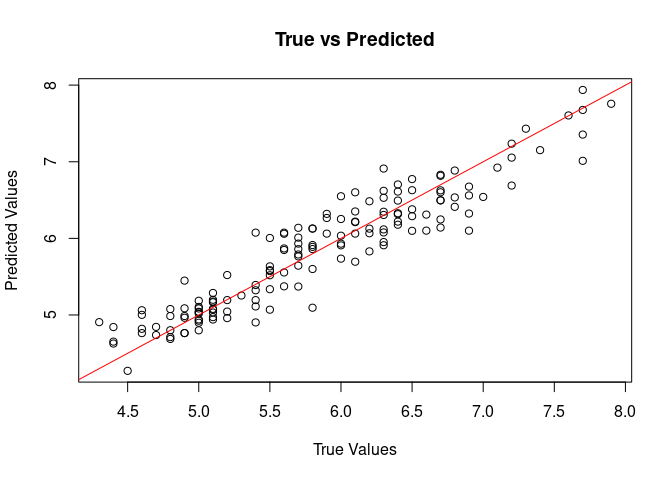
The hardware and bandwidth for this mirror is donated by dogado GmbH, the Webhosting and Full Service-Cloud Provider. Check out our Wordpress Tutorial.
If you wish to report a bug, or if you are interested in having us mirror your free-software or open-source project, please feel free to contact us at mirror[@]dogado.de.

The bnns package provides tools to fit Bayesian Neural
Networks (BNNs) for regression and classification problems. It is
designed to be flexible, supporting various network architectures,
activation functions, and output types, making it suitable for both
simple and complex data analysis tasks.
To install the bnns package from CRAN, use the
following:
install.packages("bnns")To install the bnns package from GitHub, use the
following:
# Install devtools if not already installed
if (!requireNamespace("devtools", quietly = TRUE)) {
install.packages("devtools")
}
# Install bnns
devtools::install_github("swarnendu-stat/bnns")We use the iris data for regression:
head(iris)
#> Sepal.Length Sepal.Width Petal.Length Petal.Width Species
#> 1 5.1 3.5 1.4 0.2 setosa
#> 2 4.9 3.0 1.4 0.2 setosa
#> 3 4.7 3.2 1.3 0.2 setosa
#> 4 4.6 3.1 1.5 0.2 setosa
#> 5 5.0 3.6 1.4 0.2 setosa
#> 6 5.4 3.9 1.7 0.4 setosaTo fit a Bayesian Neural Network:
library(bnns)
iris_bnn <- bnns(Sepal.Length ~ -1 + ., data = iris, L = 1, act_fn = 3, nodes = 4, out_act_fn = 1, chains = 1)Summarize the fitted model:
summary(iris_bnn)
#> Call:
#> bnns.default(formula = Sepal.Length ~ -1 + ., data = iris, L = 1,
#> nodes = 4, act_fn = 3, out_act_fn = 1, chains = 1)
#>
#> Data Summary:
#> Number of observations: 150
#> Number of features: 6
#>
#> Network Architecture:
#> Number of hidden layers: 1
#> Nodes per layer: 4
#> Activation functions: 3
#> Output activation function: 1
#>
#> Posterior Summary (Key Parameters):
#> mean se_mean sd 2.5% 25% 50%
#> w_out[1] 0.8345667 0.0728930420 0.65030179 -0.4150176 0.38054488 0.7769148
#> w_out[2] -0.3719132 0.4067431773 0.96605220 -1.7062097 -1.03225732 -0.7365945
#> w_out[3] 0.4783495 0.1965466796 0.86504113 -1.2350476 0.02944919 0.5634587
#> w_out[4] 0.4537029 0.3334670001 0.89069977 -1.3791675 0.09313077 0.5518418
#> b_out 2.2082591 0.0614548175 1.18859472 -0.1036760 1.38416657 2.2072194
#> sigma 0.3015085 0.0004831093 0.01804107 0.2693205 0.28895030 0.3013415
#> 75% 97.5% n_eff Rhat
#> w_out[1] 1.2478028 2.1730066 79.589862 1.0254227
#> w_out[2] 0.4680286 1.7548944 5.641059 1.3136052
#> w_out[3] 1.0454306 2.0448172 19.370556 1.1335888
#> w_out[4] 1.0281249 2.0733860 7.134392 1.1997484
#> b_out 3.1573563 4.2214829 374.072451 1.0016806
#> sigma 0.3128869 0.3386066 1394.549362 0.9988699
#>
#> Model Fit Information:
#> Iterations: 1000
#> Warmup: 200
#> Thinning: 1
#> Chains: 1
#>
#> Predictive Performance:
#> RMSE (training): 0.2821305
#> MAE (training): 0.2234606
#>
#> Notes:
#> Check convergence diagnostics for parameters with high R-hat values.Make predictions using the trained model:
pred <- predict(iris_bnn)Visualize true vs predicted values for regression:
plot(iris$Sepal.Length, rowMeans(pred), main = "True vs Predicted", xlab = "True Values", ylab = "Predicted Values")
abline(0, 1, col = "red")
Use bnns for regression analysis to model continuous
outcomes, such as predicting patient biomarkers in clinical trials.
model <- bnns(Sepal.Length ~ -1 + .,
data = iris, L = 1, act_fn = 3, nodes = 4,
out_act_fn = 1, chains = 1,
prior_weights = list(dist = "uniform", params = list(alpha = -1, beta = 1)),
prior_bias = list(dist = "cauchy", params = list(mu = 0, sigma = 2.5)),
prior_sigma = list(dist = "inv_gamma", params = list(alpha = 1, beta = 1))
)For binary or multiclass classification, set the
out_act_fn to 2 (binary) or 3
(multiclass). For example:
# Simulate binary classification data
df <- data.frame(
x1 = runif(10), x2 = runif(10),
y = sample(0:1, 10, replace = TRUE)
)
# Fit a binary classification BNN
model <- bnns(y ~ -1 + x1 + x2,
data = df, L = 2, nodes = c(16, 8),
act_fn = c(3, 2), out_act_fn = 2, iter = 1e2,
warmup = 5e1, chains = 1
)Explore posterior probabilities to estimate treatment effects or success probabilities in clinical trials. For example, calculate the posterior probability of achieving a clinically meaningful outcome in a given population.
help(bnns) for more information about the
bnns function and its arguments.Contributions are welcome! Please raise issues or submit pull requests on GitHub.
This package is licensed under the Apache License. See
LICENSE for details.
These binaries (installable software) and packages are in development.
They may not be fully stable and should be used with caution. We make no claims about them.
Health stats visible at Monitor.